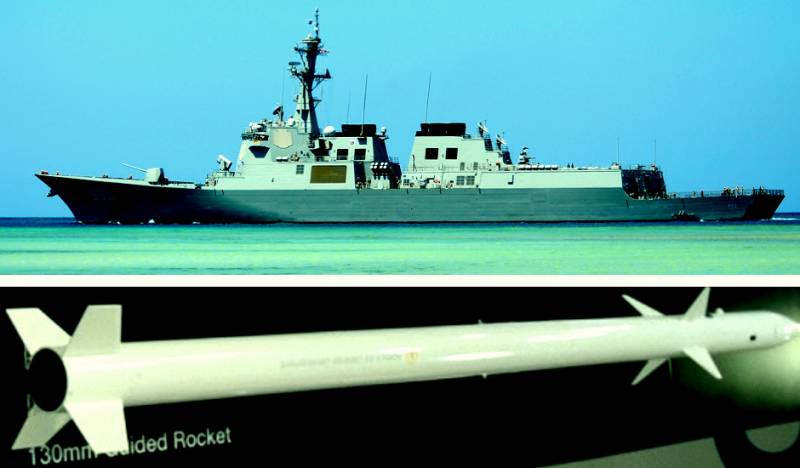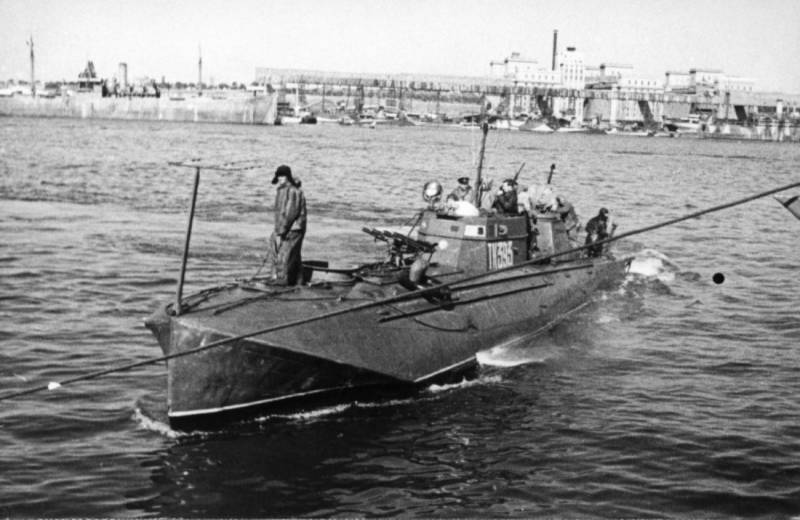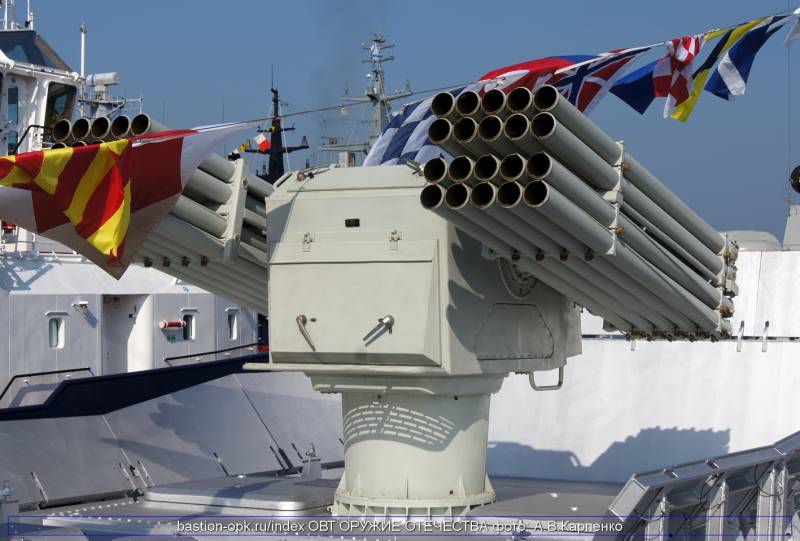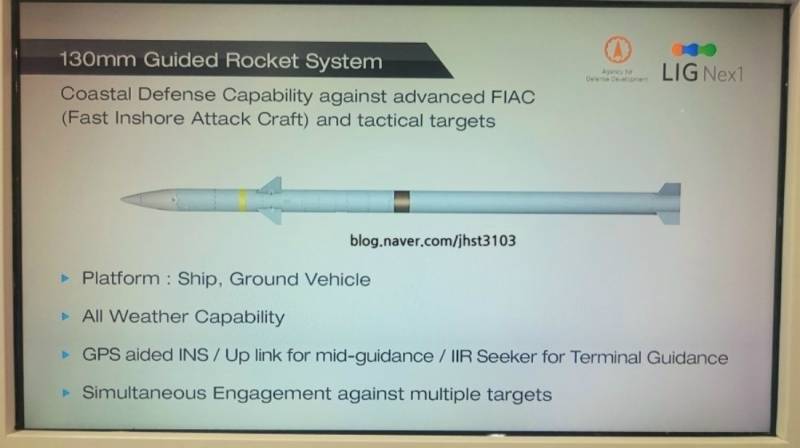Against whom is the "smart" anti-ship "Grad" of the South Korean Navy "sharpened"? What is the new project of Seoul preparing us for?
Against the backdrop of the massive scale of projects to develop long-range promising subsonic, supersonic and hypersonic anti-ship missiles for the fleets of the leading states of the world, it is sometimes difficult to consider less well-known programs to create equally formidable anti-ship complexes designed to attack enemy surface targets at a distance from 5 to 35- 40 km, but with a completely different concept of use, which came from the 40-s. XX century. Today we will talk about the perspective development of South Korean specialists - the deck jet propulsion system of the class “ship-to-ship” or “ship-to-ground”. Despite the fact that the 130-mm model of the guided missile was presented at the Polish exhibition MSPO-2017 on September 7, South Korean representatives provided an extremely narrow range of information about the new product. In view of this, it became necessary to conduct a separate analytical review based on several factors at once, including: story the development and use of similar missile weapons in the twentieth century, tactical and technical aspects of the escalation of the probable Korean conflict in our days, as well as features of the homing systems of promising tactical missiles.
The brilliant idea of using torpedo boats as carriers of unguided missiles was voiced in distant 30s. XX century Lieutenant G.V. Ternovskim. It envisaged the use of NURSs from the surface ships for direct support of the landing force and other airborne units, but in the prewar period large-scale production of missiles was not yet established, and therefore in the hardware of this concept it was destined to be embodied only a few years later production line of the most famous Soviet MLRS BM-8 and BM-13 "Katyusha"). The baptism of the first 82-mm MLRS BM-8 passed on board the "small hunter" MO-034, covering the civilian transport Pestel at the crossing. Then the MLRS shipboard calculation was able to drive away the German torpedo bomber, going into the attack on the convoy, with a sudden volley from the RS-82 projectiles.
Later, the new complex was used for its intended purpose. So, on the night of September 20, 1942, the calculation of the installation of the MLRS BM installed on board the "small hunter" MO-051 disabled the German schooner, who attempted to land a sabotage and reconnaissance group on our shore. An even more tactically important operation was carried out on the night of February 4, 1943, when the “soaked” modification of the BM-13 Katyusha MLRS mounted on the Mackerel minesweeper was first used for fire support of the landing from the sea. After demonstrating real combat potential during navy, the special design bureau Compressor was instructed to design 3 modifications of 82-mm and 132-mm MLRS adapted for ship use as soon as possible. They got the indices 8-M-8, 24-M-8 and 16-M13. Adaptation to deck placement included such update packages as reinforced fastening of rockets on guides, reducing the required effort to rotate guidance wheels in azimuth and elevation, as well as increasing the speed of guidance. These installations played a huge role in the armament systems of torpedo boats, "small and large hunters" and other ships until the end of World War II.
From the 60-ies of the 20th century, after the long-term use of aging post-war MLRS BM-14 with 140-mm NURSami M-14, the main unit of the Soviet Army's reactive artillery became the legendary 122-mm MLRS BM-21 “Grad”, designed to defeat manpower, lightly armored equipment, weakly protected support points and gearboxes, as well as anti-aircraft missile battalions and enemy artillery batteries at a distance from 4000 to 20400 m using high-explosive fragmentation missiles 9М28 and 9М22. MLRS 9K51 "Grad", included in the 13-th separate rocket artillery division (READN) 135-th motorized rifle division in the number of 12 combat vehicles, proved their effectiveness during the conflict on Damansky Island, which occurred in March and September 1969. Later, a simplified partisan modification of the complex with the 9P132 index “Partizan” (“Grad-P”) was actively used by the DRV army against units of the American army, including air bases. In total, the North Vietnamese army received more than 500 portable Grad-P launchers.
In parallel with the successes of the combat use of the partisan and mobile versions of the ground Grad MLRS, the ship modification of the 122-mm Grad-M A-215 rocket launcher system Grad-M, the tactical and technical task for the development of which was approved by the Deputy Commander of the Navy 12, was in full swing January 1966 of the year. After the factory and ground tests of the first and second prototypes of the “rifle” MLRS Grad from the end of 1969 to 1971 year, tests began on the large landing ship BDK-104 Ilya Azarov using the MS-2 launcher, the design which provided for the presence of the original below-deck charging device, which allows to update the ammunition on the PU in just 20 minutes. With the use of an unguided missile M-73OF, the ability to fire at 2-ball seas of the sea was achieved, which resulted in an excellent adaptation potential to the complex meteorological conditions on the maritime theater of military operations.
It should be noted that the RSZO A-215 Grad-M was the first to receive an advanced computerized fire control system PS-73 Thunderstorm, which not only provides a display of the presence of NURSs in the guides at the terminals of operators, but also automatically calculates the necessary azimuthal angles of warning. and elevation angles of the launcher based on target designation data from shipborne radar for detecting surface targets of the Puma / Lusk, MP-5, Vympel, 10P-03 / -123 types, etc. Moreover, in accordance with the level of pitching and rolling, as well as depending on wind direction, humidity level and pressure, correction of azimuth and vertical guidance angles of the PU can be performed. All this ensures exceptional accuracy of strikes on surface targets at a distance of more than 10 km. The first deck modification of the Grad A-215 Grad-M with the new long-range laser-optical complex DVU-2 was put into service in the 1978 year. Later, A-215 was deeply improved to A-215M. The design and operation principle of the MC-73 launcher were retained, while the MSA was replaced with the promising multi-channel SP-520М2, developed by the Concern Morinformsystem-Agat JSC. It is presented by a modern turret opto-electronic complex and an operator terminal connected by a high-speed data bus between each other and the MS-73 launcher. In the rotary turret of the optical-electronic surveillance and sighting system are located:
- day TV viewfinder with narrow (1 ° 27` x 1 ° 05` degrees) and wide (5x4 degrees) fields of view with magnification from 12 to 30 and more times;
- thermal imager with 2 or 3 generation matrix, operating in the long-wave infrared range (8 - 12 µm);
- optical device with a visual channel with wide-angle viewing mode in 19 hail. (magnification 3x) and narrow-angle 4,45 hail. (with an increase in 12 times., respectively);
- night TV viewer with wide-angle mode in 6,0 x 4,5 degrees (an increase of about 12x);
- laser rangefinder-pointer, designed to measure the distance to the target in the range from 60 to 20000 m, and possibly also for targeting to light anti-ship missiles "Whirlwind-K" with semi-active laser homing heads.
The operator's terminal is built on a fully modern computerized elemental base and is represented by three multifunctional LCD indicators of different diagonal, displaying comprehensive information about the target, including its visual and infrared image. Large-caliber A-520М, A-2 and AK-176М anti-aircraft artillery systems can also be synchronized with the SP-190М630 optic-electronic system. Later, the arsenal of the MLRS A-215М shipyards was updated: in addition to the standard 122 mm, the ZNUMXМ9У rocket missiles with the 22 km radius, upgraded NURS 20,4М9 with the 521 km range, and upgraded NNGS with the 40 km range, as well as more sophisticated NNGs with the 9M522 km with a range of 10 km, the NNRX NNRMS with the 15 km range, and newer non-advanced 92N engines a very large angle, which significantly increases the damage inflicted on the target and reduces the likelihood of interception by modern missile defense systems. Despite all the above-mentioned advantages of the “Grada-M” in the modern version, this MLRS does not belong to high-precision systems, because its missiles are still uncontrollable and have extremely low accuracy of combat, even when firing at a distance of XNUMX-XNUMX km.
The creators of the promising South Korean anti-ship / multi-purpose MLRS are ready to make a real break with the stereotypes regarding the classical principles of using multiple launch rocket systems. Obviously, the ideas that are used today in existing MLRS with corrected and guided missiles, and in anti-ship and multi-purpose missile systems will be embodied in the new product. If we compare the advanced brainchild of South Korean engineers with the existing XM30 GUMRLS (Guided Unitary MLRS) guided missile developed by Lockheed Martin together with European companies for the MLRS / HIMARS multiple launch rocket system, it’s worth noting their fundamental differences in the architecture of the guidance and control system . These differences are caused by a completely different range of tasks assigned to the new South Korean ship-based MLRS.
In particular, if the American and Chinese XM30 GUMLRS and WS-2A / C / D types of missiles are designed for long-range targeted strikes at stationary ground support points and enemy enemy equipment with XOX 30 - 50 m, then the high-speed projectiles must effectively hit high-speed ones and maneuverable (including semi-submersible) boats of the Taedong-B / C classes of the DPRK Naval Forces. For aiming and confidently defeating stationary ground objects or slow enemy armored units, it is enough to load target coordinates into the inertial navigation system URS, while the rocket must be equipped with small nasal aerodynamic rudders set in motion by compact electromechanical servo drives. After the release of the 12 URS M30 GMLRS to the battlefield with an accuracy of ± 35-50, the cassette will be revealed and the deadly “equipment” in the form of 4848 cumulative fragmentation submunitions will hit a good half of enemy units. The SPBE self-targeting combat elements with cumulative warheads can also be used. It is this bow section of the URS correction on the trajectory with small aerodynamic rudders that we see in the M / XM30 G / GUMLRS missiles, while the guidance to the required coordinates is carried out by means of a GPS module.
For the implementation of anti-ship strike (including the defeat of small-sized nimble boats of the North Korean "mosquito fleet"), fundamentally different methods of combined targeting of missiles, which require the introduction of radar and optical-electronic homing channels, are required. Satellite guidance channels in this case are completely irrelevant, especially in the landing area. The detection, tracking, and “capture” of a surface target should be made directly using the on-board active radar homing head of the millimeter Ka-band, operating in the frequency range from 26500 to 40000 MHz. Only such a method of guidance can provide the minimum circular deviation within 1 - 2 m even in difficult weather conditions, given the fact that the target maneuvers on the water surface at a speed of 45 - 52 knot, which is very typical for the North Korean Taedong-B boats / C.
The design of the controls of rockets designed to destroy mobile surface targets also cannot correspond to that used in rockets to destroy stationary or slow-moving ground targets. For the realization of a high angular velocity of the rocket turn (at the moment of approaching the maneuvering object), the design used in the XM30 projectiles — miniature nasal aerodynamic control surfaces that do not provide the necessary moment of force — is absolutely not suitable. An aerodynamic “carrier case” with advanced aerodynamic tail rudders is required (this scheme is used in anti-aircraft guided missiles 48H6X2 and MIM-104C). This is the scheme we can see in the photo of a model of a promising South Korean rocket, presented to the public at the MSPO-2017 exhibition. The photo clearly shows the 25-30-degree sweep along the leading edge of the tail feathers, which once again underlines their purpose as aerodynamic controls, because on most corrected missiles tail stabilizers have an extremely rectangular shape with a large elongation, while in the management (we repeat), we use bow thruster aerodynamic planes, or gas-dynamic means of correction.
Also, since July 2016, the existence of a modification of the ship-based 130-mm FIAC (Fast Inshore Attack Craft) salvo-launched rocket system (see photo below) has been known. It is built according to the aerodynamic “duck” scheme, but it has more advanced nose aerodynamic rudders than corrected URSs like XM30 GUMLRS. The product provides for the installation of both an active radar homing plant and an ICGSN with the possibility of radio correction from the carrier and other units on board of which there are Link-16 terminals.
Given current trends in the development of solid-propellant rocket engines, including an increase in the quality and thermodynamic properties of fuel charges, it can be argued that the range of the promising 130-mm South Korean MLRS can approach 50 - 60 km with a missile flight speed of the order of 3,5 - 4М. About the approximate dates of the start of the factory, and even more so full-scale, tests of the promising anti-ship South Korean MLRS, no information has been received so far. Nevertheless, it is already clear that the “unnamed” multipurpose MLRS can create a lot of unpleasant surprises not only for the DPRK “mosquito fleet”, but also for larger surface frigate / destroyer ships in the armed forces of the PRC and PF of the Navy. Russia.
In any case of a likely large-scale conflict in the APR, the Navy of the Republic of Korea will “play” on the side of Washington, and despite the short range of the new MRLS, any modern frigate or destroyer, even with the latest versions of the naval air defense missile system, will fall into the radius of its destruction ( “Polyment-Redut” (HQ-9B) can result in very unpleasant consequences. In particular, it would be very difficult to repel an 10 second volley from 20 small-sized guided missiles. Light fragmentation combat "equipment" of these URSov not able to send to the bottom of our or Chinese ships, but it can easily disable vital radar radios that control shipboard air defense systems. This weapon can significantly change the balance of power in the course of possible sea battles in the APR at medium distances.
Information sources:
http://rbase.new-factoria.ru/missile/wobb/a-215/a-215.shtml
http://operation-barbarossa.narod.ru/katuscha/m-13.htm
https://concern-agat.ru/produktsiya/artillerijskie-kompleksy/optiko-elektronnaya-sistema-upravleniya-sp-520.html
http://forum.militaryparitet.com/viewtopic.php?id=18325




Information